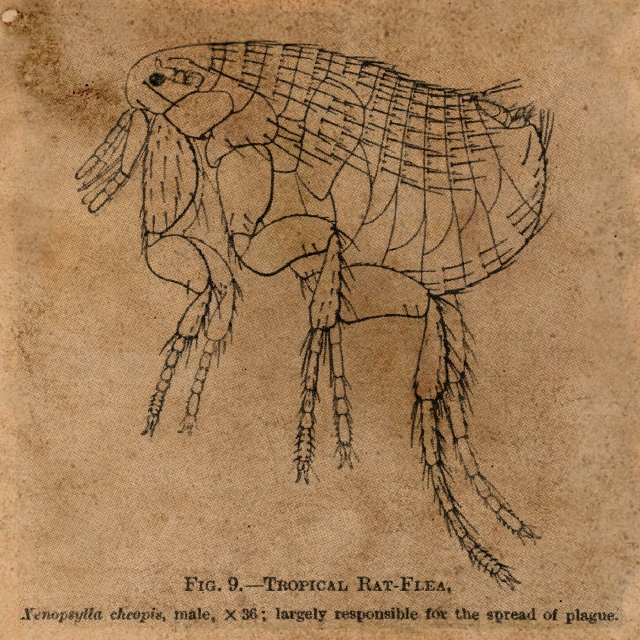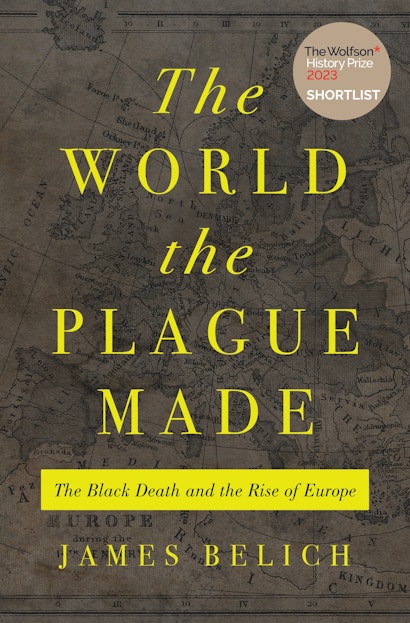During the Middle Ages, two formidable species pervaded West Eurasia: homo sapiens (humans) and rattus rattus (black rats). The two disliked each other, but literally lived in each other’s homes. In 1345, the Black Death reached them. Most believe that it came from China, but since 1885, some have suspected that Kyrgyzstan was the source. Here, tombstone epigraphs show that two villages had exceptionally high mortality in an epidemic in 1338–9. Recent science found that the Yersinia Pestis (plague) DNA ancestral to the Black Death did indeed come from Kyrgyzstan, but it had yet to be found in human remains. My book argues that, on the balance of evidence, Kyrgyzstan was the likely source, and since the time of writing a genomic study of the villager skeletons’ DNA has confirmed this (published in Nature, June 2022). I’m sorry for the villagers, but relieved that my guess was good—historians mess with science at their peril.
I go on to argue that the Black Death then made its way westward, reaching the Middle Volga in 1345. I think it had help from camel caravans (long suspected), but also from the great gerbil colonies that stretch across Kazakhstan. Great gerbils are usually plague resistant, but occasionally succumb to epidemics and transfer them quite quickly because their colonies are connected. The transmission process needs to be quite unlikely, an unusual sequence of unusual events. The deadliest plague pathogens lurked in Kyrgyzstan for 1700 years, but were transmitted to Europe only twice—the previous time being in 541, introducing the “Plague of Justinian.”
Black rat fleas are exceptionally good at injecting plague into their hosts, who are very vulnerable to plague. After 1345 some 90% of Europe’s rats died of it. The fleas then jumped to nearby humans, who can also transmit plague direct via their spittle. Human mortality is generally put at about 30%, but new findings suggest it was even worse—about 50% in most regions. Worse still, rats breed like rats and the few survivors quickly bred back. Rat movement can transmit plague on its own, but only slowly. Grain is their favourite food, and adventurous rats hide in large cargoes of it, spreading plague fast. So multiple widespread plagues followed the first, slowly tailing off from about 1500. These repeated hammer blows helped forge modern Europe.
It seems almost inhumane to find a silver lining in a cloud as dark as this terrible human tragedy, but so it was. Survivors found that, on average, they had twice as much of everything: buildings, livestock, fertile acres, ships and wagons, as well as cash and valuables. Lords and laws strove to prevent it, but serfdom declined fast, and peasant incomes improved, as did wages—skeletal evidence shows that average heights increased. The higher orders also did well (inheritances doubled, for example), but this a rare period in which inequality diminished—with disproportionate effects on consumer demand, which was very modest before the plague. If your net income was $10, and subsistence cost $9, then your disposable income was only $1. If your income increased 50%, and subsistence remained the same, then your disposable income increased 500%. Suddenly, common folk gate-crashed the market, seeking more cured fish for Lent, and even some sugar and pepper; more metal tools and utensils; and better clothing. The middle orders joined the higher orders in the market for spices, silks, and furs. Slavery, previously in decline because non-slave labour was so cheap, revived. Sources of prime furs and slaves within Europe were already depleted, and as early as the 1360s Iberians were raiding for slaves in the Canary Islands, while Russians crossed Urals to exact tribute in sables from the locals. So plague created motives for expansion. But motives are not means. The peoples of the Canaries and the trans-Urals were tough customers, and Europeans struggled to subdue them for the first century. Then the second dimension of plague’s ruthless revolution stepped in.
Scarce and expensive human labour forced a sharp turn to waterpower, gun powder, and wind power. Among many uses, water powered blast furnaces that partly replaced human operated bellows in European iron production, which rocketed towards Chinese levels. Sweden was the big iron exporter, and records suggest a sixfold increase in Swedish iron production, 1340–1539. Gunpowder weapons were used in Europe before plague, but they were ineffective except as frighteners. I trace a sequence of improvements from 1360 to 1470, producing cast bronze cannon, and adequate handguns. Handguns (harquebuses) were not yet better than bows, but they were labour-saving. Training a hand gunner took a few months; training a bowman a few years. Plague-improved Ottoman guns were just as good as European ones, as were their gun galleys and riverine gunboats, and it was the Ottomans who pioneered modern regular armies and state centralization. They forced European powers to step up and match them, and blocked European expansion southwards—I call this “the Great Diversion.”
There was one plague effect that the Ottomans—and most Christian states—did not share, because they did not possess a decent stretch of Atlantic coast: the gun galleon. Expensive labour made galleys too costly for trade, though not war. This was a particular problem in the Atlantic, with unpredictable winds and dangerous lee shores. So three masted full-rigged ships developed by 1409, more maneouvrable than sail-only precursors, and able to handle most seas and seasons. Guns on ships were common enough by 1400, but not multiple big guns mounted below deck. I argue that these emerged in the Atlantic states, in clearly plague-pressured steps, by about 1480—a half-century early than some experts suggest. Gun galleons, with 20 cannon or more, were a necessary, though not sufficient, condition of European empire overseas. In effect, guns multiplied small numbers, while galleons enabled Europeans to scout the world’s coasts, looking for opportunities, like eagles or vultures, depending on perspective.
This is a mere taste of the Black Death’s impacts. There were social, cultural, ideological, religious, political, and gendered effects, all of which I at least touch on in the book. A personal favourite is spectacles. There was a sudden need to extend the working days and working lives of surviving scribes and copyists, artisans and artists. Glasses mitigated both fading light and fading sight. Eyeglasses existed before the plague but proliferated massively after it. Florence, Venice, and Barcelona—heavily plagued cities—produced thousands of pairs a year from 1403 at the latest. For the world outside, the great impact was successive tides of West Eurasian expansion, some of it successful. It was caused, not by any long-standing superiority, but by the grasping of new opportunities created by terrible plagues.
I’d been working on this book for a decade before COVID struck us. I turned down media requests to compare it to the Black Death because I would have had to say that the latter was very much worse, which felt heartless. Maybe I was wrong. The Western Front was much worse than today’s multiple American mass shootings, but it remains possible that the two have something to teach each other—cherished principles curdling into stubborn inhumanity, the blunting of tragedy through repetition. Anyway, the lesson from the Black Death is wider than COVID. History has always been an interplay between human agency and the environment. We can never take the latter for granted.
James Belich is the Beit Professor of Imperial and Commonwealth History at the University of Oxford and cofounder of the Oxford Centre for Global History. His books include Replenishing the Earth: The Settler Revolution and the Rise of the Anglo-World, 1783–1939.

